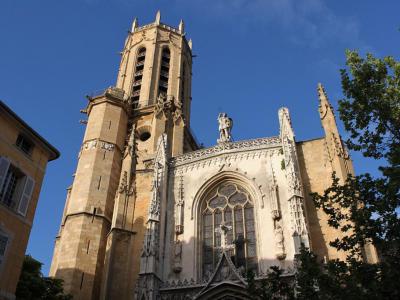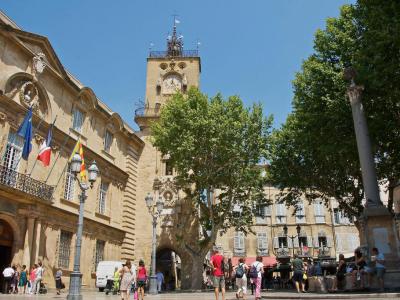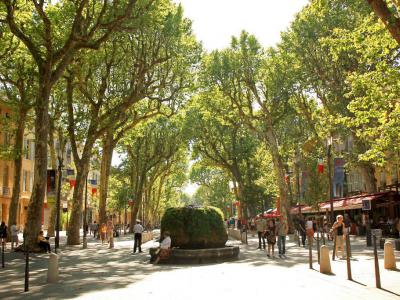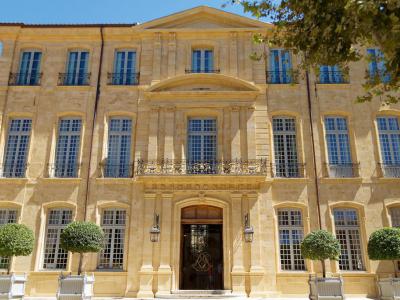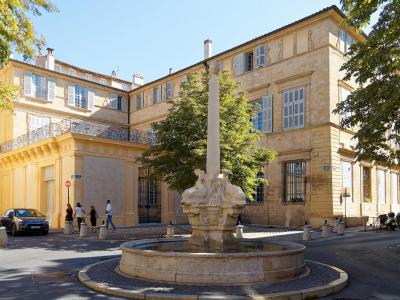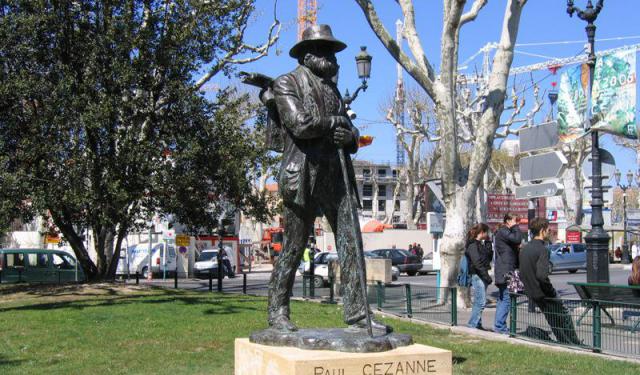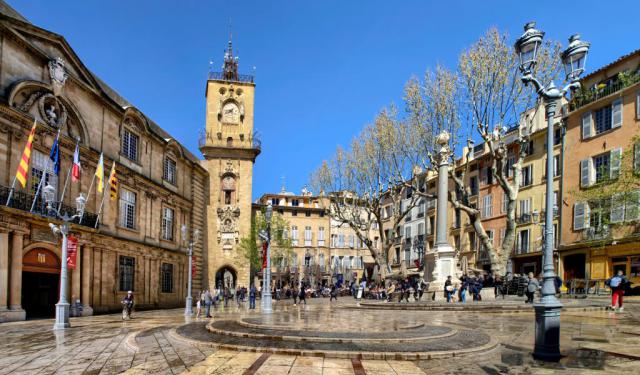
Aix-en-Provence Introduction Walking Tour (Self Guided), Aix-en-Provence
Aix-en-Provence is a city in southern France, about 30 km (or 20 mi) north of Marseille. Aix was founded by Roman Consul Sextius Calvinus in 123 BC. Calvinus called it Aquae Sextiae, which means "Waters of Sextius," after the warm springs in the area. During the Middle Ages, it was the capital of Provence.
Aix reached a high point after the 12th century as it began to emerge as a center of art and culture under the houses of Aragon and Anjou. In 1487 it became French.
Mirabeau Boulevard is a wide avenue lined with plane trees. The old town, in the north, has narrow, medieval lanes and mansions of the 16th, 17th, and 18th centuries. South of Mirabeau Boulevard is the Mazarin District, a 17th-century gentrification project of Cardinal Mazarin. Aix is often called the city of a thousand fountains. The most remarkable ones are on Mirabeau Boulevard. Medieval Aix Cathedral sits on a Roman Forum.
Aix-en-Provence is the hometown of French Post-Impressionist painter Paul Cezanne. There is a pedestrian route called the Cezanne Trail. It begins at the statue of Cezanne at Mirabeau Boulevard, marking his birthplace, schools, and studios.
There are popular musical events throughout the year. The Aix Festival of Lyric Art rivals the festivals of Bayreuth and Salzburg. The Grand Theater of Provence hosts operas and music events. Music in the Street is held each June along with the Festival of Music.
Aix-en-Provence is not a coastal town, although it is not far from the Riviera shore. Frantic development has passed it by. It remains a center of culture and pleasure where the arts are revered, and the climate is great.
Paul Cezanne said he always missed Aix when he was away from it. Even Paris could not hold him. The father of Cubism was right. Aix will leave its impression. Come, see how it will impress you.
Aix reached a high point after the 12th century as it began to emerge as a center of art and culture under the houses of Aragon and Anjou. In 1487 it became French.
Mirabeau Boulevard is a wide avenue lined with plane trees. The old town, in the north, has narrow, medieval lanes and mansions of the 16th, 17th, and 18th centuries. South of Mirabeau Boulevard is the Mazarin District, a 17th-century gentrification project of Cardinal Mazarin. Aix is often called the city of a thousand fountains. The most remarkable ones are on Mirabeau Boulevard. Medieval Aix Cathedral sits on a Roman Forum.
Aix-en-Provence is the hometown of French Post-Impressionist painter Paul Cezanne. There is a pedestrian route called the Cezanne Trail. It begins at the statue of Cezanne at Mirabeau Boulevard, marking his birthplace, schools, and studios.
There are popular musical events throughout the year. The Aix Festival of Lyric Art rivals the festivals of Bayreuth and Salzburg. The Grand Theater of Provence hosts operas and music events. Music in the Street is held each June along with the Festival of Music.
Aix-en-Provence is not a coastal town, although it is not far from the Riviera shore. Frantic development has passed it by. It remains a center of culture and pleasure where the arts are revered, and the climate is great.
Paul Cezanne said he always missed Aix when he was away from it. Even Paris could not hold him. The father of Cubism was right. Aix will leave its impression. Come, see how it will impress you.
How it works: Download the app "GPSmyCity: Walks in 1K+ Cities" from Apple App Store or Google Play Store to your mobile phone or tablet. The app turns your mobile device into a personal tour guide and its built-in GPS navigation functions guide you from one tour stop to next. The app works offline, so no data plan is needed when traveling abroad.
Aix-en-Provence Introduction Walking Tour Map
Guide Name: Aix-en-Provence Introduction Walking Tour
Guide Location: France » Aix-en-Provence (See other walking tours in Aix-en-Provence)
Guide Type: Self-guided Walking Tour (Sightseeing)
# of Attractions: 10
Tour Duration: 1 Hour(s)
Travel Distance: 1.7 Km or 1.1 Miles
Author: nataly
Sight(s) Featured in This Guide:
Guide Location: France » Aix-en-Provence (See other walking tours in Aix-en-Provence)
Guide Type: Self-guided Walking Tour (Sightseeing)
# of Attractions: 10
Tour Duration: 1 Hour(s)
Travel Distance: 1.7 Km or 1.1 Miles
Author: nataly
Sight(s) Featured in This Guide:
- Cathedrale Saint-Sauveur d'Aix-en-Provence (Aix Cathedral)
- Place de l'Hôtel de Ville (Town Hall Square)
- Place et Fontaine d'Albertas (Albertas Square and Fountain)
- Fontaine de la Rotonde (Fountain of the Rotunda)
- Cours Mirabeau (Mirabeau Boulevard)
- Hotel de Caumont (Caumont Hotel)
- Mazarin District and Fountain of the Four Dolphins
- Eglise Saint-Jean-de-Malte (Church of St. John)
- Musee Granet (Granet Museum)
- Rue d'Italie (Italy Street)
1) Cathedrale Saint-Sauveur d'Aix-en-Provence (Aix Cathedral) (must see)
The 17th-century French writer and historian Jean Scholastique Pitton claimed the Aix Cathedral (Cathedrale Saint-Sauveur d'Aix-en-Provence) was built on the top of a Roman temple dedicated to Apollo, one of the Olympian deities in classical Greek and Roman religion and mythology. Tradition holds that the first church on the site was founded by Saint Maximinus in 500 AD. It is said that Maximinus arrived in Aix from Jerusalem with Mary Magdalene in a boat on loan from Saint Lazarus.
The current Cathedral of Aix was built in the 12th century. It had Romanesque walls and one wide nave. A second nave, dedicated to Saint Maximinus, was established between the first nave and the baptistry in 1171. Two new wings of the transept, built in the Gothic style, were added in 1318.
The main portal doors, made of carved red walnut, were installed in 1505. The western facade has extravagant Gothic portals. The yellowish buttresses have lengthy, narrow niches with pinnacles. Three statues of the Apostles stand on either side of the doorway. The remaining six Apostles hide in the side buttresses on each side.
Above the portal and gable, a statue of the archangel Michael, sculpted by Jean Paumier in 1507, skewers a supine dragon on the Gothic balustrade of the facade. The single 16th-century bell tower is 210 feet high.
The Aix Cathedral has a triple nave: a Romanesque side aisle, a Gothic central nave, and a Baroque 17th-century north aisle. The bishop's throne is in the Choir Gallery. The altar is supported by three bronze statues representing the Holy Trinity. The Baptistry Rotunda and its Roman columns date from the 5th century.
Artworks in the Cathedral include the Burning Bush Triptych (1475-1476) by French painter Nicolas Froment; Christ on the Cross (1640) and The Last Supper (1688) by Flemish artist Jean Daret; The Incredulity of Saint Thomas (1613) by Louis Finson, the follower of the famous Italian painter Caravaggio; the Altar of the Aygosi Family placed in the cathedral in 1823; and a set of 17 tapestries of the Life of Christ bought in 1656. The tapestries were woven in 1511 for Canterbury Cathedral in England and decorated the choir until 1642.
Paul Cezanne, the father of the cubist movement in France, was a native of Aix. He claimed it was the best place to live. He painted several canvases of the Aix Cathedral, a short walk from his studio. His funeral was held there in October 1906.
The current Cathedral of Aix was built in the 12th century. It had Romanesque walls and one wide nave. A second nave, dedicated to Saint Maximinus, was established between the first nave and the baptistry in 1171. Two new wings of the transept, built in the Gothic style, were added in 1318.
The main portal doors, made of carved red walnut, were installed in 1505. The western facade has extravagant Gothic portals. The yellowish buttresses have lengthy, narrow niches with pinnacles. Three statues of the Apostles stand on either side of the doorway. The remaining six Apostles hide in the side buttresses on each side.
Above the portal and gable, a statue of the archangel Michael, sculpted by Jean Paumier in 1507, skewers a supine dragon on the Gothic balustrade of the facade. The single 16th-century bell tower is 210 feet high.
The Aix Cathedral has a triple nave: a Romanesque side aisle, a Gothic central nave, and a Baroque 17th-century north aisle. The bishop's throne is in the Choir Gallery. The altar is supported by three bronze statues representing the Holy Trinity. The Baptistry Rotunda and its Roman columns date from the 5th century.
Artworks in the Cathedral include the Burning Bush Triptych (1475-1476) by French painter Nicolas Froment; Christ on the Cross (1640) and The Last Supper (1688) by Flemish artist Jean Daret; The Incredulity of Saint Thomas (1613) by Louis Finson, the follower of the famous Italian painter Caravaggio; the Altar of the Aygosi Family placed in the cathedral in 1823; and a set of 17 tapestries of the Life of Christ bought in 1656. The tapestries were woven in 1511 for Canterbury Cathedral in England and decorated the choir until 1642.
Paul Cezanne, the father of the cubist movement in France, was a native of Aix. He claimed it was the best place to live. He painted several canvases of the Aix Cathedral, a short walk from his studio. His funeral was held there in October 1906.
2) Place de l'Hôtel de Ville (Town Hall Square) (must see)
The Place de l'Hôtel de Ville (Town Hall Square) of Aix is arguably one of Provence’s most famous squares, located in the city center, in front of the Town Hall. The current Town Hall, constructed in 1678, is a rebuild of the original structure dating from the 14th century. It was built by architect Pierre Pavillon assisted by sculptors Jean-Claude Rambot and Jacques Fosse. The famous French painter Paul Cezanne married Marie-Hortense Fiquet in the Town Hall in 1886.
The square is at the foot of the white limestone Clock Tower, built in 1510, which holds an astronomical clock dating from 1661. A cage at the top houses the medieval bell of the ban used to announce an exercise of Seigneurial rights, which obliged peasants to provide the landowner with seigneurial dues, paid either in cash, produce, or labor.
The 18th-century Corn Exchange Hall is located between Town Hall Square and Richelme Square. The ornately decorated former Corn Exchange building now houses the municipal library and post office. In the center of the square is a fountain created by Jean-Pancrace Chastel in 1755 and topped with a Roman column.
The square is home to a few cafes and restaurants, making it a nice spot to stop for coffee or a bite to eat. There is also a flower market in the square on Tuesdays, Thursdays, and Saturdays. A book fair is on the first Sunday of each month.
The square is at the foot of the white limestone Clock Tower, built in 1510, which holds an astronomical clock dating from 1661. A cage at the top houses the medieval bell of the ban used to announce an exercise of Seigneurial rights, which obliged peasants to provide the landowner with seigneurial dues, paid either in cash, produce, or labor.
The 18th-century Corn Exchange Hall is located between Town Hall Square and Richelme Square. The ornately decorated former Corn Exchange building now houses the municipal library and post office. In the center of the square is a fountain created by Jean-Pancrace Chastel in 1755 and topped with a Roman column.
The square is home to a few cafes and restaurants, making it a nice spot to stop for coffee or a bite to eat. There is also a flower market in the square on Tuesdays, Thursdays, and Saturdays. A book fair is on the first Sunday of each month.
3) Place et Fontaine d'Albertas (Albertas Square and Fountain)
Jean Agar, the adviser to the Parliament of Aix in the 16th century, sold his house to a family from Marseilles, the Paulhes. The Paulhes, in turn, sold the house to the d'Albertas family in the 18th century. The d'Albertas were originally from Alba, Italy. They settled in Provence in the 14th century.
In 1724, the Marquis Henri Reynaud d'Albertas, adviser to the King, engaged Laurent Vallon, architect of the city, to give his mansion a serious re-do. Henri had bought houses opposite his residence and had them demolished. Henri died in 1746. His son, Jean-Baptiste d'Albertas, entrusted Georges Vallon, son of Laurent, to carry on.
Georges Vallon, the new architect of the city, built an elegant small square in front of the d'Albertas residence, modeled after the royal plazas of Paris. Four mansions line the square (Place d'Albertas). They have near identical facades and wrought-iron balconies before large windows.
The fountain monument (Fontaine d'Albertas) is a large chalice of cast iron standing in a large circular pool. The pool is surrounded by a miniature iron railing fashioned by students of the School of Arts and Crafts of Aix-en-Provence.
In 1724, the Marquis Henri Reynaud d'Albertas, adviser to the King, engaged Laurent Vallon, architect of the city, to give his mansion a serious re-do. Henri had bought houses opposite his residence and had them demolished. Henri died in 1746. His son, Jean-Baptiste d'Albertas, entrusted Georges Vallon, son of Laurent, to carry on.
Georges Vallon, the new architect of the city, built an elegant small square in front of the d'Albertas residence, modeled after the royal plazas of Paris. Four mansions line the square (Place d'Albertas). They have near identical facades and wrought-iron balconies before large windows.
The fountain monument (Fontaine d'Albertas) is a large chalice of cast iron standing in a large circular pool. The pool is surrounded by a miniature iron railing fashioned by students of the School of Arts and Crafts of Aix-en-Provence.
4) Fontaine de la Rotonde (Fountain of the Rotunda)
The Count de Valbelle died in 1779. But before he died, he donated to the city of Aix of 30,000 livres. In November of that year, it was decided to demolish the ramparts in the area and build a square. Various plans were put forward to embellish the new Rotunda Square.
To mark the entrance to the city without ramparts and fortified gates, a large fountain and obelisk were planned on the square. It was to be many years before the project took shape. Finally, in 1860, the fountain was designed by architect Theophile de Tournadre.
Since the Roman period, Aix city has had the reputation of the water capital of the region for its several terms and fountains. The Fountain of the Rotunda (Fontaine de la Rotonde), the most imposing fountain in Aix-en-Provence, became the city's symbol not only for its exceptional dimensions but also for being the first to have a cast iron basin.
The stone fountain and obelisk are nearly 40 feet high. Below is a large circular pool surrounded by a chain cast at the Aix Centre of Arts and Crafts. Six pairs of lions recline on marble bases around the edges.
Groups of children ride bronze swans in the basin. Above this basin is another, smaller one. This bowl is surmounted by a pedestal adorned with spouting cheetah heads crafted by sculptor Francois Truphème.
Three female statues stand on the pedestal facing in three directions. "Justice" by Joseph Marius Ramus looks to the Cours Mirabeau in the direction of the Courthouse. "Commerce and Agriculture" by Louis-Felix Chabaud face Marseille and the industrial sites. "Fine Arts" by Hippolyte Ferrat turns towards the Avignon, showing the establishment of the universities in the city. Collectively, the statues are called "The Three Graces."
To mark the entrance to the city without ramparts and fortified gates, a large fountain and obelisk were planned on the square. It was to be many years before the project took shape. Finally, in 1860, the fountain was designed by architect Theophile de Tournadre.
Since the Roman period, Aix city has had the reputation of the water capital of the region for its several terms and fountains. The Fountain of the Rotunda (Fontaine de la Rotonde), the most imposing fountain in Aix-en-Provence, became the city's symbol not only for its exceptional dimensions but also for being the first to have a cast iron basin.
The stone fountain and obelisk are nearly 40 feet high. Below is a large circular pool surrounded by a chain cast at the Aix Centre of Arts and Crafts. Six pairs of lions recline on marble bases around the edges.
Groups of children ride bronze swans in the basin. Above this basin is another, smaller one. This bowl is surmounted by a pedestal adorned with spouting cheetah heads crafted by sculptor Francois Truphème.
Three female statues stand on the pedestal facing in three directions. "Justice" by Joseph Marius Ramus looks to the Cours Mirabeau in the direction of the Courthouse. "Commerce and Agriculture" by Louis-Felix Chabaud face Marseille and the industrial sites. "Fine Arts" by Hippolyte Ferrat turns towards the Avignon, showing the establishment of the universities in the city. Collectively, the statues are called "The Three Graces."
5) Cours Mirabeau (Mirabeau Boulevard) (must see)
Honore-Gabriel Riqueti, Comte de Mirabeau, was an early leader of the French Revolution. He represented Aix at the historic Estates General assembly of 1789. He was for liberty while a secret supporter of the Monarchy. When he died in 1791, the nation mourned.
The Mirabeau Boulevard (Cours Mirabeau) in Aix is named in his honor. The street is one of the important axes of the city center of Aix. In 1649, as the municipality was expanding, the city's south rampart was demolished to make way for expansion projects planned by archbishop Michel Mazarin.
Mazarin's dream was a grand promenade for the wealthy bourgeois who would live in his new district. Simply called "le Cours" (Boulevard) at the time, the street was 1,445 feet long and 138 feet wide. With the assistance of architect Jean Lombard, Mazarin had drawn up plans for a new urban area. The boulevard replaced the rampart as a carriage course.
It took fifteen years to remove pieces of the old rampart and open the street so the nobility could have a place to stroll on a Sunday. The Mirabeau Boulevard is a veritable tunnel of plane trees lined with cafes, terraces, and mansions with wrought-iron balconies. The name "Mirabeau" was awarded to the street in 1876.
The Mirabeau Boulevard is decorated with fountains. Besides the most notable Fountain of the Rotunda (1860), designed by architect Theophile de Tournadre, there is the Fountain of the Nine Canons (1651), designed by Laurent Vallon, and the Mossy Fountain, built by Jacques Fosse in 1667. It runs hot water and is covered in moss. The Fountain of the Seahorses at the bottom of the street was destroyed in 1777. Only a mound remains.
At the east end of the boulevard is a statue of King Rene, restored in 2009. Some of the old mansions have been replaced with shops and markets. The street is somewhat ambivalent today, like the politics of Royalist/Revolutionary Mirabeau.
The Mirabeau Boulevard (Cours Mirabeau) in Aix is named in his honor. The street is one of the important axes of the city center of Aix. In 1649, as the municipality was expanding, the city's south rampart was demolished to make way for expansion projects planned by archbishop Michel Mazarin.
Mazarin's dream was a grand promenade for the wealthy bourgeois who would live in his new district. Simply called "le Cours" (Boulevard) at the time, the street was 1,445 feet long and 138 feet wide. With the assistance of architect Jean Lombard, Mazarin had drawn up plans for a new urban area. The boulevard replaced the rampart as a carriage course.
It took fifteen years to remove pieces of the old rampart and open the street so the nobility could have a place to stroll on a Sunday. The Mirabeau Boulevard is a veritable tunnel of plane trees lined with cafes, terraces, and mansions with wrought-iron balconies. The name "Mirabeau" was awarded to the street in 1876.
The Mirabeau Boulevard is decorated with fountains. Besides the most notable Fountain of the Rotunda (1860), designed by architect Theophile de Tournadre, there is the Fountain of the Nine Canons (1651), designed by Laurent Vallon, and the Mossy Fountain, built by Jacques Fosse in 1667. It runs hot water and is covered in moss. The Fountain of the Seahorses at the bottom of the street was destroyed in 1777. Only a mound remains.
At the east end of the boulevard is a statue of King Rene, restored in 2009. Some of the old mansions have been replaced with shops and markets. The street is somewhat ambivalent today, like the politics of Royalist/Revolutionary Mirabeau.
6) Hotel de Caumont (Caumont Hotel) (must see)
The Hotel de Caumont (Caumont Hotel), a museum venue, was a formerly private residence. It was designed by architects Robert de Cotte and Georges Vallon in 1715. It was built for Francois Rolland de Reauville de Tertulle, Marquess of Cabannes. Sculptors Jean-Baptiste Rambot and Bernard Toro created the Atlas near the main entrance.
The hotel passed through several owners from 1715 to 1964, when it was sold to the city of Aix. It was rented to the postal service up to 1970. Until 2013 it was home to the music school, Darius Milhaud Conservatory. The hotel was for high-status homeowners of the chic Mazarin Quarter. It had rooms dedicated to music and socializing.
In the music room is a frame of a harpsichord of the 18th century, carved by harp maker Jean-Henri Naderman. Gilt plasterwork on the ceiling show cherubs at play. The 18th-century bedrooms display the fashion of the time for alcoves and boudoirs. The walls are covered with Rococo motifs, garlands, and Middle-Eastern monkeys.
Hotel de Caumont features a paved Court of Honor and more than 1,000 square meters of gardens. There is also an art center, which houses temporary exhibitions of the greatest artists. The foyer has an indoor fountain. There are two staircases for family and staff. Sections of the house and garden are shown as they were at best. There is a gift shop and a small theatre.
The hotel passed through several owners from 1715 to 1964, when it was sold to the city of Aix. It was rented to the postal service up to 1970. Until 2013 it was home to the music school, Darius Milhaud Conservatory. The hotel was for high-status homeowners of the chic Mazarin Quarter. It had rooms dedicated to music and socializing.
In the music room is a frame of a harpsichord of the 18th century, carved by harp maker Jean-Henri Naderman. Gilt plasterwork on the ceiling show cherubs at play. The 18th-century bedrooms display the fashion of the time for alcoves and boudoirs. The walls are covered with Rococo motifs, garlands, and Middle-Eastern monkeys.
Hotel de Caumont features a paved Court of Honor and more than 1,000 square meters of gardens. There is also an art center, which houses temporary exhibitions of the greatest artists. The foyer has an indoor fountain. There are two staircases for family and staff. Sections of the house and garden are shown as they were at best. There is a gift shop and a small theatre.
7) Mazarin District and Fountain of the Four Dolphins
The Square of the Four Dolphins is in the heart of the Mazarin district (Quartier Mazarin) of Aix. It is at the intersection of Cardinal Street (rue Cardinale) and September 4th Street (rue Quatre-Septembre) next to Mirabeau Boulevard. The square is surrounded by mansions, including the Boisgelin Hotel, designed by architect Pierre Pavillon in 1655. In the center of the square is the Fountain of the Four Dolphins (Fontaine des Quatre Dauphins).
In 1645, the archbishop of Aix, Michel Mazarin, received King Louis XIV's permission to demolish the south ramparts of the city to build a modern upscale district in their place. Mazarin entrusted his urban planning to architect Jean Lombard. The area was laid out in a checkerboard grid and inspired by Italian Renaissance ideas.
In the center of the new district, Lombard built a square that he called Saint-Michel Square. Today it goes by the name the Square of the Four Dolphins. The fountain in the middle of the square is the work of sculptor Jean-Claude Rambot. It shows four ornate dolphins around a pyramid supporting a column holding a pine cone. The dolphins spout water into a large circular pool below. Four chestnut trees, planted in the square, surround the fountain.
In 1645, the archbishop of Aix, Michel Mazarin, received King Louis XIV's permission to demolish the south ramparts of the city to build a modern upscale district in their place. Mazarin entrusted his urban planning to architect Jean Lombard. The area was laid out in a checkerboard grid and inspired by Italian Renaissance ideas.
In the center of the new district, Lombard built a square that he called Saint-Michel Square. Today it goes by the name the Square of the Four Dolphins. The fountain in the middle of the square is the work of sculptor Jean-Claude Rambot. It shows four ornate dolphins around a pyramid supporting a column holding a pine cone. The dolphins spout water into a large circular pool below. Four chestnut trees, planted in the square, surround the fountain.
8) Eglise Saint-Jean-de-Malte (Church of St. John)
The Eglise Saint-Jean-de-Malte (Church of Saint John) is located at the corner of Italy Street and Cardinal Street in Aix. It is the first Gothic Catholic Church in Provence. It dates from the 13th century, probably from around 1270. The site of the church was initially occupied by a hospice and chapel of the Knights Hospitaller of the Order of Malta.
In the 17th century, the parish was integrated into the city when the town ramparts were moved south to create the new Mazarin district. During the French Revolution, the church was looted of most of its treasures and converted into a military warehouse. Not until Napoleon appeared on the scene was the church restored to the parish.
The church's interior may be seen in Michelangelo Antonioni's 1995 film Beyond the Clouds. A new large window, installed in the apse in 1858, was designed by several artists of Aix. In the upper quatrefoils, God the Father blesses Count Ramon Berenguer IV and Beatrice of Provence. Below them are three Hospitallers of Malta.
The church restocked paintings since it was re-established. There is Sir Henry Pleading with the Virgin (1687) by Jean Armelin; The Annunciation (1678) by Andre Boisson; Resurrection (1610) by Louis Finson; Descent from the Cross (1612) by Andre Gaudion; Saint Bruno (1663) by Reynaud Levieux; The Crucifixion (1820) by Delacroix and many others.
In the 17th century, the parish was integrated into the city when the town ramparts were moved south to create the new Mazarin district. During the French Revolution, the church was looted of most of its treasures and converted into a military warehouse. Not until Napoleon appeared on the scene was the church restored to the parish.
The church's interior may be seen in Michelangelo Antonioni's 1995 film Beyond the Clouds. A new large window, installed in the apse in 1858, was designed by several artists of Aix. In the upper quatrefoils, God the Father blesses Count Ramon Berenguer IV and Beatrice of Provence. Below them are three Hospitallers of Malta.
The church restocked paintings since it was re-established. There is Sir Henry Pleading with the Virgin (1687) by Jean Armelin; The Annunciation (1678) by Andre Boisson; Resurrection (1610) by Louis Finson; Descent from the Cross (1612) by Andre Gaudion; Saint Bruno (1663) by Reynaud Levieux; The Crucifixion (1820) by Delacroix and many others.
9) Musee Granet (Granet Museum) (must see)
Henri Pointier, the curator of the Museum of Aix from 1892 to 1925, despised Cezanne. He is said to have declared Cézanne would only be shown there "Over my dead body." Mr. Pointier proved to be prophetic. He died in 1949, and the hunt was on for works by Cezanne. In the same year, the Aix museum took the name of one of its most generous benefactors, the local painter François-Marius Granet.
The Musee Granet (Granet Museum) first opened in a building once the property of the priory of Saint Jean-de-Malte. Today it still shares a garden with the church. In 2009 it mounted an exhibition marking the 100th anniversary of Cezanne's death, absolutely a painter's revenge.
The museum contains paintings by Jean-Dominique Ingres, including the massive masterpiece "Jupiter and Thetis." There is a self-portrait by Rembrandt and other works by Van Dyck, Cezanne, Giacometti, and de Stael.
In June 2011, the Foundation Jean et Suzanne Planque opened a show at the Granet Museum. It contained over 180 works, all the legacy of the great Swiss collector Jean Planque. The collection has a run of 15 years at the museum.
The complete collection will number more than 300 works of art. Degas, Renoir, Monet, Cezanne, Van Gogh, Picasso, Bonnard, Klee, Giacometti, and Dubuffet will be there. The show is housed in a special annex in the Chapel of the White Penitents.
The Musee Granet (Granet Museum) first opened in a building once the property of the priory of Saint Jean-de-Malte. Today it still shares a garden with the church. In 2009 it mounted an exhibition marking the 100th anniversary of Cezanne's death, absolutely a painter's revenge.
The museum contains paintings by Jean-Dominique Ingres, including the massive masterpiece "Jupiter and Thetis." There is a self-portrait by Rembrandt and other works by Van Dyck, Cezanne, Giacometti, and de Stael.
In June 2011, the Foundation Jean et Suzanne Planque opened a show at the Granet Museum. It contained over 180 works, all the legacy of the great Swiss collector Jean Planque. The collection has a run of 15 years at the museum.
The complete collection will number more than 300 works of art. Degas, Renoir, Monet, Cezanne, Van Gogh, Picasso, Bonnard, Klee, Giacometti, and Dubuffet will be there. The show is housed in a special annex in the Chapel of the White Penitents.
10) Rue d'Italie (Italy Street)
Rue d'Italie (Italy Street) is one of the oldest streets in the city and one of the oldest urban streets in France. Named in honor of Emperor Napoleon Bonaparte's victorious campaigns in Italy, it was created by an extension of the ancient Roman street, Aurelia. The Aurelia street passed through the colony of the Baths of Sextius on its way between Rome and Spain. The territory was founded by the Roman consul Gaius Sextius Calvinus in the 2nd century BC.
In the Middle Ages, the street was the "Way of Saint Maximinus." As the Church of Saint John of Malta was on the road, it came to be called the "Way of Saint John." In 1540 a manor near the Church of St. John was demolished to erect fortifications. In 1671 a priory was built by Jean-Claude Viany, a chaplain of the order of Saint John of Jerusalem. In 1838 the priory became the Musee Granet.
Italy Street is in the old Mazarin district. The street is lined with simple townhouses, shops, and cafes. Have drinks at A Casa pub and bar or enjoy a meal at La Dolce Italia restaurant. The Musee Granet and its Cezanne collection are nearby. Italy Street is also one of the most commercial and tourist-friendly streets.
The narrow Italy Street houses several restaurants. The pavement is cobbled with colorful Provencal stones. Part of the church of Saint John of Malta faces the street. Need a break? Stop at the lunchtime-only restaurant "Between Noon and Two" (Entre Midi et Deux). Enjoy!
In the Middle Ages, the street was the "Way of Saint Maximinus." As the Church of Saint John of Malta was on the road, it came to be called the "Way of Saint John." In 1540 a manor near the Church of St. John was demolished to erect fortifications. In 1671 a priory was built by Jean-Claude Viany, a chaplain of the order of Saint John of Jerusalem. In 1838 the priory became the Musee Granet.
Italy Street is in the old Mazarin district. The street is lined with simple townhouses, shops, and cafes. Have drinks at A Casa pub and bar or enjoy a meal at La Dolce Italia restaurant. The Musee Granet and its Cezanne collection are nearby. Italy Street is also one of the most commercial and tourist-friendly streets.
The narrow Italy Street houses several restaurants. The pavement is cobbled with colorful Provencal stones. Part of the church of Saint John of Malta faces the street. Need a break? Stop at the lunchtime-only restaurant "Between Noon and Two" (Entre Midi et Deux). Enjoy!
Walking Tours in Aix-en-Provence, France
Create Your Own Walk in Aix-en-Provence
Creating your own self-guided walk in Aix-en-Provence is easy and fun. Choose the city attractions that you want to see and a walk route map will be created just for you. You can even set your hotel as the start point of the walk.
Aix-en-Provence Fountains and Squares Tour
Aix-end-Provence is known for its fountains. With more than 1,000 fountains, a tourist could spend weeks walking around the city without glimpsing them all. The fountains began appearing under the Roman empire when the Romans discovered Aix's natural thermal water source. They referred to the area as Aquae Sextiae or the Waters of Sextius.
The fountains appear throughout the city and are... view more
Tour Duration: 1 Hour(s)
Travel Distance: 1.6 Km or 1 Miles
The fountains appear throughout the city and are... view more
Tour Duration: 1 Hour(s)
Travel Distance: 1.6 Km or 1 Miles
In the Footsteps of Paul Cézanne
Paul Cezanne created a scandal. While staying at the home of Doctor Paul Gachet in Auvers-sur-Oise, he painted an homage to Edouard Manet's work, Olympia, based on Titian's Venus of Urbino. Titian painted a goddess. Manet painted a prostitute. In his "New Olympia," Cezanne painted himself in the painting.
The nude New Olympia, seemingly a muse, reclines on her couch.... view more
Tour Duration: 2 Hour(s)
Travel Distance: 3.0 Km or 1.9 Miles
The nude New Olympia, seemingly a muse, reclines on her couch.... view more
Tour Duration: 2 Hour(s)
Travel Distance: 3.0 Km or 1.9 Miles
The Most Popular Cities
/ view all
